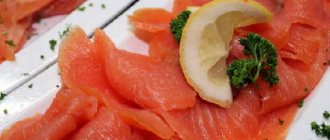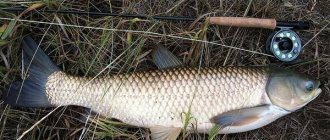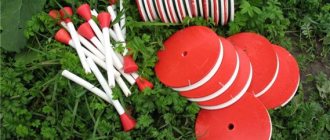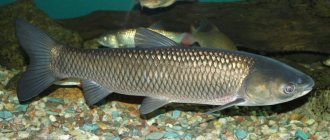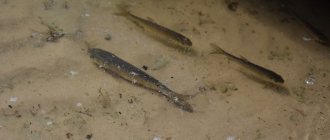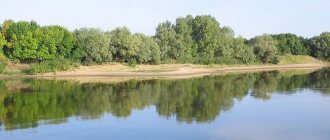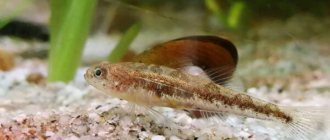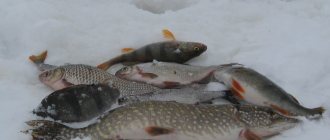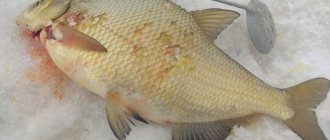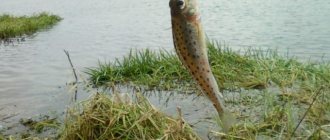- Wild animals
- >>
- Fish
White carp is a large and beautiful fish from the Carp family. It is valued for its beneficial properties. It grows quickly and adapts well to the ecological niches of various fresh water bodies. It is a commercial fish. Possessing excellent taste, it also brings additional benefits to water bodies, effectively clearing them of excess aquatic vegetation on which it feeds.
Origin of the species and description
Photo: White Cupid
Grass carp (Ctenopharyngon idella) belongs to the Carp family, order Cypriniformes, class Bony fish. This species comes from East Asia, where its distribution is still high, starting from the Amur River and reaching the southern Chinese borders.
Video: Grass Cupid
Belamur appeared in Russian rivers under the Soviet Union, when in the early 60s it was introduced and acclimatized to effectively combat abundant aquatic vegetation. It cleans water bodies very effectively, eating up to 2 kg of aquatic plants per 1 kg of its body weight within one day. On average, a large adult individual can eat about 20-30 kg of algae per day.
Interesting fact: Grass carp is able to eat not only underwater plants, but can also eat terrestrial vegetation, for this purpose it goes to places where rivers flood. Cases have been recorded of representatives of the species jumping out of the water to grab land plants.
This species is found in central irrigation canals and ponds used for cooling power plants. In such natural conditions, the fish is not able to spawn, and its reproduction occurs with the help of larvae brought from the Krasnodar Territory and Moldova.
White carp is a useful fish that is bred for commercial purposes. Has excellent taste. The meat is fatty, tasty and dense, white in color, nutritious. The liver of grass carp is also valuable; it is also used for food; the liver is large, with a high fat content.
Fishing technique and tactics
Belamur feeds non-stop from early morning until late evening. But it’s better to catch it in the first half of the day, when the fish are as hungry as possible. To avoid spooking the prey with unnecessary noise and movements, a long cast is required. If the school is close to the shore, the angler takes a position to the side and casts the bait diagonally. But fishing from the opposite shore is especially popular.
To learn more:
What is included in Minenko boilies?
You should not throw in bait at the very beginning of fishing, which, falling into the water, can scare away the peacefully feeding fish. You should create a bait cloud of turbidity only when there has not been a single bite for an hour or an hour and a half. Sometimes it is advisable to attach several promising places at once, and start fishing in a calmly unfed area.
When to hook and how to fish out
The hooking time depends on the type of nozzle. If there is a bunch of greenery or a piece of cabbage leaf on the hook, you need to wait for the tip of the feeder or float to constantly tremble and make a sharp and strong swing of the rod. With compact baits (boilie, crawler, corn), grass carp does not stand on ceremony, immediately grabs it and tries to stroke it. In such a situation, an immediate hook is required as soon as the bite alarm goes off.
Fishing for grass carp requires maximum concentration. He will definitely show strong resistance and try to hide in aquatic vegetation. Quite often, the fish meekly follows to the shore, creating a misleading impression of its size. But at some point it makes a powerful jerk, and if the clutch on the reel is not loosened, a breakdown follows.
Appearance and features
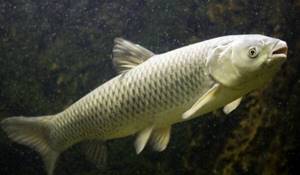
Photo: Grass carp fish
Grass carp is a fairly large fish, reaching a length of 1.2 m and a weight of up to 40 kg. The body has an elongated valval shape, with some flattening noted on the sides. The head is low, the mouth is set straight, the rear edge of the mouth does not extend beyond the front edge of the eyes in a vertical line. The forehead is very wide.
The teeth are special - pharyngeal, arranged in 2 rows, compressed in the lateral direction, the edge of the teeth is very sharp, can be compared to a saw, with an uneven serrated surface. The scales are large, dense, with a dark stripe located at the very edge of each scale. The scales on the abdomen are light, without a rim. The back and belly between the fins have a rounded shape.
Fins:
- the dorsal fin has a somewhat rounded shape, starts slightly in front of the ventral fins, the fin is high, but not long, has 7 branched rays and 3 unbranched ones;
- pelvic fins do not reach the anus;
- the anal fin has a slightly rounded shape, small size, has 8 branched and 3 unbranched rays;
- the caudal fin is large, its notch is medium.
All fins are light, except for the caudal and dorsal. The back of grass carp is green with a gray tint, the sides are light golden, with 40-47 scales located along the lateral line. Above the gills there is a gill cover, on which stripes diverge radially. Gills with sparse and short stamens. The eyes have a golden iris. Grass carp has 42-46 vertebrae and a dark, almost black peritoneum.
Calorie content of fish
Grass carp fits perfectly into any diet. It contains very few calories - only about 125 per 100 grams of product and very little fat. But if you cook it by frying, the volume of fat in the final dish increases.
Did you know? In one day, grass carp consumes as much vegetation as it weighs.
100 g of raw fish contains:
- protein - 17%, which is 79% of the carcass weight;
- fat - 2%, accounting for 21% of the total mass;
- carbohydrates - 0%.
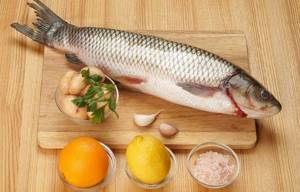
Where does White Cupid live?
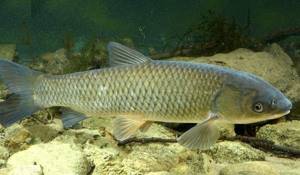
Photo: Live grass carp
The natural habitats of the fish are East Asia, namely, from the Amur River and south to Xijiang. In Russia, Amur lives in the river of the same name, its middle and lower reaches. For the purpose of acclimatization, in the 60s of the 20th century, fish were released into many rivers of the USSR.
Among which:
- Don;
- Dnieper;
- Volga;
- Kuban;
- Amur;
- Yenisei and others.
The move-in was carried out with the aim of clearing plant accumulations.
The introduction of fish into freshwater bodies was also carried out:
- North America;
- Europe;
- Asia;
- on Sakhalin.
The main purpose of the introduction is the reproduction of fish as an object for fish farming. It spawns mainly in the Songhua River, Lake Khanka, the Ussuri River, in the rivers of China, on the Don, and on the Volga. Now grass carp lives in almost all reservoirs, large lakes and river-lake systems:
- Moldova;
- European part of Russia;
- Belarus;
- Central Asia;
- Ukraine;
- Kazakhstan.
The presence of fish in rivers, reservoirs and pond farms is ensured only through artificial propagation.
What does grass carp eat?
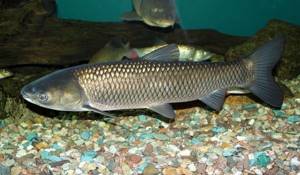
Photo: Grass carp fish
An important condition for the existence of fish is the presence of abundant higher vegetation, since grass carp is a herbivorous fish and feeds exclusively on plants. The food for young grass carp initially consists of zooplankton and small crustaceans. As it grows, upon reaching an intestinal length of 6 to 10 cm, the fish switches to feeding on plants.
Plant food is the main component of the diet, but sometimes individuals of the species can eat young fish. Unpretentiousness to food is the main feature of eating behavior. While in the pond, you can happily eat the food that is designed for carp.
Plant food preferred by grass carp:
- soft grass;
- elodea;
- duckweed;
- thread;
- chilim;
- hornwort;
- pondweed;
- reed leaves;
- sedge;
- hard algae.
It prefers easily accessible food, so it likes the soft stems and pre-cut leaves of reeds. However, when there is no “favorite” food, cupid begins to eat everything, indiscriminately including emergent plants, which it pulls and uproots. He eats some of it, but spits out a lot of it. It can eat beet tops, cabbage leaves, and clover.
The temperature range from 25 to 30° C is best suited for active feeding of carp. The weight of food eaten at this temperature range is up to 120% of its own weight. The digestion process in this species occurs quickly; food passing through the short gastrointestinal tract is not completely absorbed. Very rarely, as an option, it eats insects, leeches, and mollusks.
Interesting fact: In the winter, when the temperature is low and there is not enough, and sometimes no plant food at all, it may not eat at all. This occurs due to the fact that the body has accumulated a supply of nutrients during the period of active nutrition. At the same time, there is a decrease in metabolism and all body functions of individuals.
How to cook deliciously
In the Far East they know well what kind of fish grass carp is. Many recipes for its preparation appeared in the cold regions of Russia, China and Japan, from where they spread into the cuisines of the peoples of the world.
Fishermen usually cook fish soup from the heads, tails and fins of freshly caught grass carp right on the shore. To prepare it you need: cereals, spices, onions, carrots.
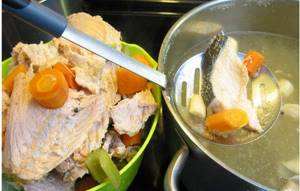
Amur ear
Cooking over the fire:
- Cook chopped vegetables, cereals, and spices in a cauldron for 15-20 minutes;
- Add the head, fins, and tail to the vegetable broth and let it simmer for another 30-40 minutes;
- 5 minutes before serving, pour a shot of vodka inside to add flavor.
The dish is camping, so it’s simple and satisfying. It won't get worse if you add fish steak, update the recipe with herbs, and cook it at home on the stove.
Stuffed grass carp is spicy, sweetish, excellent quality for Asian cuisine. You can cook in the oven, in a fire, on a grill grate. Vegetables include eggplants, peppers and onions. Additionally, for the dish you will have to buy ginger and spices - for fish, starch, soy sauce and rice vinegar - for basting.
Prepared in foil:
- Through longitudinal cuts, the fillet is removed from the bones and the backbone is discarded;
- The fillet is generously salted, rubbed with pepper and spices;
- Onions, eggplants, peppers, ginger are chopped;
- Vegetables are sauteed for 5 minutes in a cauldron over a fire or in a frying pan without oil;
- The vegetable filling is mixed with soy sauce and wrapped with fillet;
- Fillet rolls are wrapped in foil, pre-moistened with water with starch, rice vinegar and soy sauce.
Baked cupid is cooked in the fire and oven for 30-40 minutes, on the grill - 60-65 minutes. Before serving, the fillet is once again poured with the starch-soy mixture. It turns out juicy and aromatic.
Stewed grass carp is prepared in pieces in vegetable stew. Vegetables you need are celery, carrots, and cucumbers. You will also need olives, herbs, mushrooms and a little flour as a thickener for the soup.
Cook in a saucepan on the stove or in a cauldron over an open fire:
- Pieces of fish are salted, sprinkled with lemon juice and left in the refrigerator for an hour;
- Olive mushrooms and cucumbers are stewed with the addition of a small amount of water;
- Add peeled and chopped celery and carrots to them;
- Boil for 15-20 minutes, after which add the fish;
- Simmer the mixture for a long time - up to an hour, until the fish is boiled;
- 10 minutes before the end of cooking, add 1-2 tablespoons of flour to thicken the dish.
A dietary recipe suitable for children. Sometimes there is a slightly modified version of stewing - in red semi-sweet wine. The sweetness of the grapes harmoniously combines with the spicy meat of the fish.
Fried carp meatballs will be appreciated by lovers of fried food. The only additional products you need for fish are eggs, butter and flour. It must be cut without bones. The fillet is cut into pieces 4-5 cm thick.
Prepared in a frying pan with heated oil:
- Pieces of fish are rolled in a mixture of flour, salt and pepper;
- Dip into a raw egg before adding to the frying pan;
- Fry without a lid until golden brown on both sides;
- Steam under the lid for 8-10 minutes.
The meatballs are served with a variety of sauces. When there is no time to cook. Traditional soy or tomato ketchup with paprika is suitable.
Grass carp is not a fish for beginner fishermen. It’s better to train on someone smaller. But the massive relative of the carp is very tasty. Dishes containing it contain an impressive supply of Omega microelements, useful for maintaining youth and health. Delicious sweetish fish fillet of river Amur is fried, boiled in the ear, baked with vegetables, and fried in batter.
Features of character and lifestyle
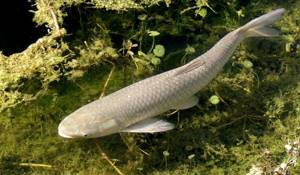
Photo: Grass carp fish
Belamur in its natural habitat migrates depending on seasonal frequency. When it is warm, it is found in the appendages of rivers, and closer to cold weather and during winter it lives in the river bed, where it can gather in flocks in holes in the river bottom.
Grass carp is a stenophage, that is, it uses a definitely narrow range of food for feeding - these are mostly aquatic plants; it can also use terrestrial plants growing on the slopes of rivers and reservoirs. To tear off the plant, it uses its jaws, and with the help of its pharyngeal teeth, the plant fibers are ground. Young animals less than 3 cm can be used to feed on small crustaceans, crustaceans and rotifers.
Sexual maturity occurs at different times in different habitats. So, in its native environment - the Amur River basin, sexual maturity occurs by 10 years. In Chinese rivers a little earlier, by 8-9 years.
Interesting fact: Representatives of the species living in the rivers of Cuba reach sexual maturity very early, at 1-2 years of age.
The eggs are spawned in portions, the spawning is spread out over time:
- in Chinese rivers from April to August;
- in the Amur basin during June and July. Simultaneous spawning is also assumed.
The eggs are pelagic, meaning they float in the water column. 3 days after the eggs are laid, the larvae hatch from them; it is important that the water temperature should not be lower than 20°C. The fry soon move towards the shore, where they have all the necessary conditions, including food - insects, larvae, small crustaceans, algae. After body growth of 3 cm, it switches to feeding on vegetation.
Belamur is not shy, but very cautious. He has places to hide, for example, at the bottom of a river hole or in branches. The routes along which the fish swim are the same. In sunny times it likes to swim in the upper warm layers of the reservoir.
Spicy fish with a crispy crust
Required:
- grass carp carcass or fillet – 3-4 kg;
- hot pepper pod;
- several garlic cloves;
- seasoning: ground (black) pepper or original hops-suneli;
- table salt is added according to personal preferences;
- baking flour, premium – 3 tbsp. l.;
- vegetable-based oil - 50 g.
By clicking on the link - - you can find out how to quickly clean the scales of river and river perch. The easiest way is to treat with boiling water. Read more about this.
After reading the article “Soy meat: benefits and harms,” you will learn several recipes for its preparation, and you will also know that it can easily replace natural meat. This is especially true for those losing weight.
How to cook:
- If you take a carcass, you will have to gut it thoroughly. The fins of the fish are cut off because it will be more convenient to eat this way. You also need to remove the skin and scales. The gills, like the entrails, are necessarily separated from the fish. The meat must be washed with running water. Dry it with a paper towel.
- The pepper is cleared of seeds and stalks. Then, using a blender or food processor, it must be turned into a mushy mass.
- Pepper gruel, seasoning, salt and garlic pressed through a garlic press are mixed in one container, adding vegetable oil.
- The prepared grass carp fillet is rubbed on all sides with the resulting mixture, and soaked in it for an hour and a half.
- The soaked fish fillet is cut into portions or left whole. It is breaded and placed in a silicone or metal baking dish.
- The oven is heated to 2000C. The “semi-finished product” is placed in the oven for 30 minutes.
- An excellent side dish for the finished dish would be boiled potato tubers, fluffy rice, fried, or fresh vegetables in the form of a salad. You can also make a simple horseradish-based sauce for the fish, or use mayonnaise, mustard or soy sauce as an addition.
Return to content
Social structure and reproduction
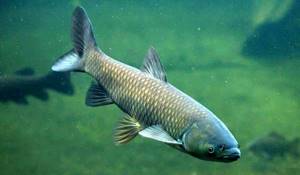
Photo: Belamur
Adult individuals of this species can gather in schools, this is especially noticeable during wintering, which the fish spend in holes at the bottom of the river.
Interesting fact: During the cold winter season, special skin glands produce a viscous secretion, the whitish threads of which can float in the water, thus revealing places of significant concentration of fish.
After reaching sexual maturity (on average 7 years) in the summer, grass carp goes to spawn. It should be shallow water, with a hard bottom, the base of which is stone or clay. An important condition is the presence of an adequate current and a water temperature of 25°C.
On average, the female spawns about 3.5 thousand eggs, floating in the upper warm layers of water, which then spread with the flow of water. After 3 days, larvae emerge from the eggs.
Within a week, the larva, having previously secured itself on the underwater plants of the reservoir, grows into a fry. The fry, being in the coastal zone, feeds on zooplankton and benthos organisms. When he reaches a height of 3 cm, Malek switches to a vegetarian diet.
Interesting fact: Under unfavorable conditions - lack of food, strong currents, sharp temperature fluctuations, reproduction stops and the eggs are destroyed, the so-called resorption.
Natural enemies of grass cupids
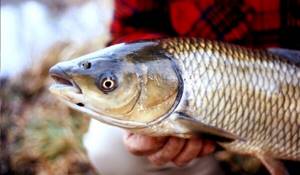
Photo: White Cupid
The adult White Cupid has an impressive size, thanks to which it has no natural enemies in freshwater rivers. But for still small, growing individuals there are many dangers, including:
- unfavorable climatic conditions, sharp temperature fluctuations, changes in flow speed, droughts, floods;
- insects, amphibians, and other animals that can feed on eggs. Considering that not so many eggs are spawned, this may even threaten the existence of the population;
- for small and medium-sized fish, the threat is posed by predator fish, including pike and catfish, only if we are talking about open reservoirs;
- birds living near bodies of water, as well as waterfowl, can feed on small and middle-aged representatives of the species, which also negatively affects the quantitative characteristics of the population;
- a man with his careless and sometimes greedy attitude towards fishing.
Since White Cupid is a very tasty and healthy fish, every fisherman strives to catch it. Environmental problems, unfortunately, appear on an alarming scale. Waters are polluted by waste and discharges from chemical production; to increase benefits, growth factors and hormones are added to feed, changing the entire biocenosis of ecological systems.
Habitats
Fish live in schools. Cupid is characterized by great endurance; it easily survives in conditions unsuitable for life for other species of the carp family. It can live in salt water (up to 10 grams/liter) and tolerates frosty winters quite well.
Grass carp prefers to live in places with an abundance of aquatic vegetation. Therefore, most often it can be found on water utilities, small rivers and reservoirs. Again, when you are looking for fish, you should pay attention to places where there is a lot of algae.
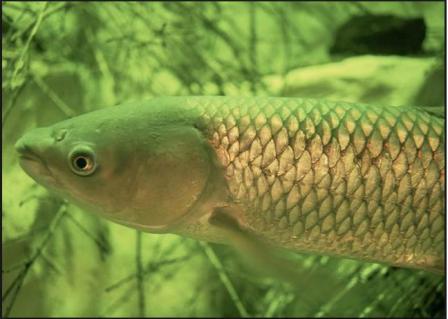
It prefers to live in reservoirs with a large food supply, but spawns only in the current. In most rivers of central Russia, grass carp has completely acclimatized and its population is increasing. So this fish is not in danger of extinction.
